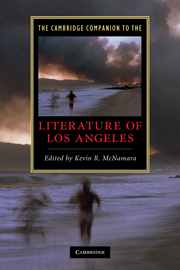Book contents
- Frontmatter
- Introduction: landmarks
- 1 The literature of the Californios
- 2 The Anglo invention of Los Angeles
- 3 LA fiction through mid-century
- 4 British expatriates and German exiles in 1930s-1940s Los Angeles
- 5 Postwar Los Angeles: suburban Eden and the fall into history
- 6 Los Angeles and the African-American literary imagination
- 7 Pacific Rim city: Asian-American and Latino literature
- 8 The literature of urban rebellion
- 9 City of sleuths
- 10 Los Angeles’ science fiction futures
- 11 Hollywood fictions
- 12 The Southland on screen
- 13 Scenes and movements in Southern California poetry
- 14 Surf, sagebrush, and cement rivers: Reimagining nature in Los Angeles
- 15 Essaying Los Angeles
- Guide to further reading
- Index
12 - The Southland on screen
Published online by Cambridge University Press: 28 May 2010
- Frontmatter
- Introduction: landmarks
- 1 The literature of the Californios
- 2 The Anglo invention of Los Angeles
- 3 LA fiction through mid-century
- 4 British expatriates and German exiles in 1930s-1940s Los Angeles
- 5 Postwar Los Angeles: suburban Eden and the fall into history
- 6 Los Angeles and the African-American literary imagination
- 7 Pacific Rim city: Asian-American and Latino literature
- 8 The literature of urban rebellion
- 9 City of sleuths
- 10 Los Angeles’ science fiction futures
- 11 Hollywood fictions
- 12 The Southland on screen
- 13 Scenes and movements in Southern California poetry
- 14 Surf, sagebrush, and cement rivers: Reimagining nature in Los Angeles
- 15 Essaying Los Angeles
- Guide to further reading
- Index
Summary
Surely no single city has such a close relationship with motion pictures as Los Angeles, which has appeared on screen in myriad guises for over a century since a film crew employed by Thomas Edison's Edison Manufacturing Company arrived in December 1897. South Spring Street, Los Angeles, California (1898), a twenty-five-second “actuality” film shot by Frederick Blechynden, captured a sense of Los Angeles as a metropolis-in-the-making by presenting a view of pedestrian and horse-drawn traffic on that busy downtown commercial thoroughfare. Painters and photographers had long flocked to Southern California for its climate, sunlight, Mediterranean landscapes, and the romantic appeal of its Spanish and Mexican heritage. D. W. Griffith first captured these ingredients on celluloid in Ramona (1910), a fifteen-minute adaptation of Helen Hunt Jackson's novel. Offering a utopian image of the region as a combination of flower-filled garden and expansive wilderness waiting to be exploited, Ramona assisted the civic boosters in marketing Los Angeles as an ideal place in which to live and work. Ramona was remade in 1916, 1928, and 1936, while another romantic Mexican legend, that of Zorro, was adapted for the screen in 1920, 1925, 1937, 1946, and 1949.
- Type
- Chapter
- Information
- The Cambridge Companion to the Literature of Los Angeles , pp. 145 - 156Publisher: Cambridge University PressPrint publication year: 2010

